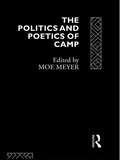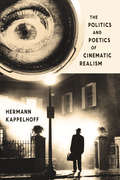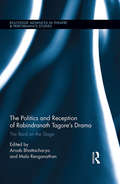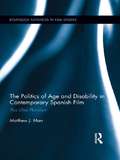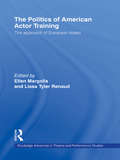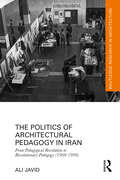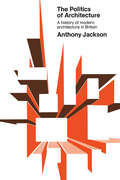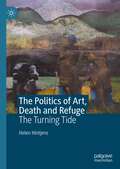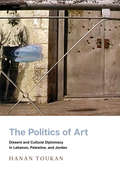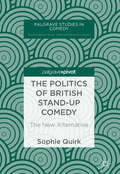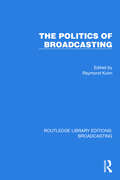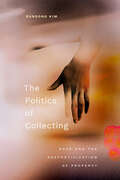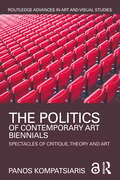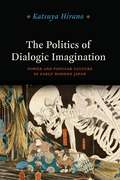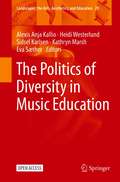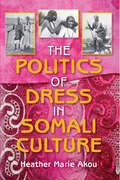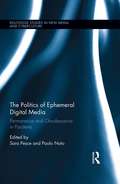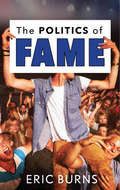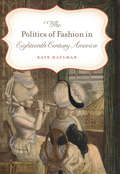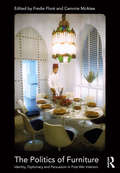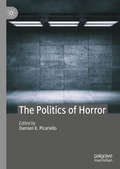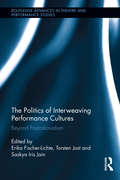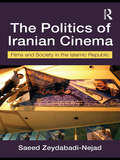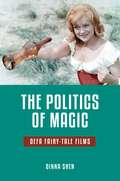- Table View
- List View
The Politics and Poetics of Camp
by Moe MeyerThe Politics and Poetics of Camp is a radical reappraisal of the meaning and discourse of camp. The contributors look at both the meaning and the uses of camp performance, and ask: is camp a style, or a witty but nonetheless powerful cultural critique? The essays investigate camp from its early formations in the seventeenth and eighteenth century to its present manifestations in queer theatre and literature. They also take a fascinating look at the complex relationship between queer discourse and decidedly un-queer pop culture appropriations on film and on the stage. The Politics and Poetics of Camp is an incisive, uncontainable and entertaining collection of essays by some of the foremost critics working in queer theory, from a number of disciplinary perspectives. This book makes a well-timed intervention into an emerging debate.
The Politics and Poetics of Cinematic Realism (Columbia Themes in Philosophy, Social Criticism, and the Arts)
by Hermann KappelhoffHermann Kappelhoff casts the evolution of cinema as an ongoing struggle to relate audiences to their historical moment. Appreciating cinema's unique ability to bind concrete living conditions to individual experience (which existing political institutions cannot), he reads films by Sergei Eisenstein and Pedro Almodóvar, by the New Objectivity and the New Hollywood, to demonstrate how cinema situates spectators within society. Kappelhoff applies the Deleuzean practice of "thinking in images" to his analysis of films and incorporates the approaches of Jacques Rancière and Richard Rorty, who see politics in the permanent reconfiguration of poetic forms. This enables him to conceptualize film as a medium that continually renews the audiovisual spaces and temporalities through which audiences confront reality. Revitalizing the reading of films by Visconti, Fassbinder, Kubrick, Friedkin, and others, Kappelhoff affirms cinema's historical significance while discovering its engagement with politics as a realm of experience.
The Politics and Reception of Rabindranath Tagore's Drama: The Bard on the Stage (Routledge Advances in Theatre & Performance Studies)
by Arnab Bhattacharya Mala RenganathanThis is the first volume to focus specifically on Rabindranath Tagore’s dramatic literature, visiting translations and adaptations of Tagore’s drama, and cross-cultural encounters in his works. As Asia’s first Nobel Laureate, Tagore’s highly original plays occupy a central position in the Indian theatrescape. Tagore experimented with dance, music, dance drama, and plays, exploring concepts of environment, education, gender and women, postcolonial encounters, romantic idealism, and universality. Tagore’s drama plays a generous host to experimentations with new performance modes, like the writing and staging of an all-women play on stage for the first time, or the use of cross-cultural styles such as Manipuri dance, Thai craft in stage design, or the Baul singing styles. This book is an exciting re-exploration of Tagore’s plays, visiting issues such as his contribution to Indian drama, drama and environment, feminist readings, postcolonial engagements, cross-cultural encounters, drama as performance, translational and adaptation modes, the non-translated or the non-translatable Tagore drama, Tagore drama in the 21st century, and Indian film. The volume serves as a wide-ranging and up-to-date resource on the criticism of Tagore drama, and will appeal to a range of Theatre and Performance scholars as well as those interested in Indian theatre, literature, and film.
The Politics of Age and Disability in Contemporary Spanish Film: Plus Ultra Pluralism (Routledge Advances in Film Studies)
by Matthew J. MarrThe Politics of Age and Disability in Contemporary Spanish Film examines the onscreen construction of adolescent, elderly, and disabled subjects in Spanish cinema from 1992 to the present. Applying a dual lens of film analysis and theory drawn from the allied fields of youth, age, and disability studies, this study is set both within and against a conversation on cultural diversity—with respect to gender, sexual, and ethnic identity—which has driven not only much of the past decade’s most visible and fruitful scholarship on representation in Spanish film, but also the broader parameters of discourse on post-Transition Spain in the humanities. Presenting an engaging, and heretofore under-explored, interdisciplinary approach to images of multiculturalism in what has emerged as one of recent Spain’s most vibrant areas of cultural production, this book brings a fresh, while still complementary, critical sensibility to the field of contemporary Peninsular film studies through its detailed discussion of six contemporary films (by Salvador García Ruiz, Achero Mañas, Santiago Aguilar & Luis Guridi, Marcos Carnevale, Alejandro Amenábar, and Pedro Almodóvar) and supporting reference to the production of other prominent and emerging filmmakers.
The Politics of American Actor Training (Routledge Advances in Theatre & Performance Studies)
by Ellen Margolis Lissa Tyler RenaudThis book addresses the historical, social, colonial, and administrative contexts that determine today's U.S. actor training, as well as matters of identity politics, access, and marginalization as they emerge in classrooms and rehearsal halls. It considers persistent, questioning voices about our nation’s acting training as it stands, thereby contributing to the national dialogue the diverse perspectives and proposals needed to keep American actor training dynamic and germane, both within the U.S. and abroad. Prominent academics and artists view actor training through a political, cultural or ethical lens, tackling fraught topics about power as it plays out in acting curricula and classrooms. The essays in this volume offer a survey of trends in thinking on actor training and investigate the way American theatre expresses our national identity through the globalization of arts education policy and in the politics of our curriculum decisions.
The Politics of Architectural Pedagogy in Iran: From Pedagogical Revolution to Revolutionary Pedagogy (1960-1990) (Routledge Research in Architecture)
by Ali JavidThe Politics of Architectural Pedagogy in Iran explores the evolution of architectural pedagogy during two significant socio-political upheavals in Iran: The White Revolution (1963) and the Islamic Revolution (1979). It examines how these transformative periods influenced the field, providing valuable insights into the intersection of architectural education and broader socio-political shifts in Iran.By examining the critical role of education in achieving geopolitical objectives during the Cold War, this book explores architectural pedagogy as an agent for resistance and revolution. It highlights how architectural pedagogy not only reflects radical ideologies but also actively engages in socio-political transformation. The book uncovers how architectural pedagogy became one of the mechanisms to accomplish revolutionary goals. This is evident in initiatives like the "Pedagogical Revolution" during the White Revolution (1963), aimed at modernizing educational institutions, and the "Revolutionary Pedagogy" during the Islamic Revolution (1979), which sought to serve the masses and the religious revolutionary society. In this way, the book adds a new geopolitical perspective to the contemporary discourse of radical pedagogies.This book explores the intricate connections between architectural pedagogy and politics through a transdisciplinary approach. It analyzes original multilingual documents, including political agendas, cultural agreements, curricula, teaching methods, student works, exhibitions, and conferences. It will be of interest to architectural historians and architecture students, particularly those interested in Global South development, modernism, architectural pedagogy, international relations, and Middle Eastern studies.
The Politics of Architecture: A history of modern architecture in Britain
by Anthony JacksonThe history of British architecture since 1930 has been one of frequently heated controversy between the old idiom and the new and between various social and technological viewpoints. The battle is by no means over; indeed it is spreading to wider issues and outside what was previously a largely professional sphere. A book like this one, which spells out the issues and describes how they arose, is therefore of interest not only to architects and students of architecture but to the growing general public concerned about the man-made environment. Professor Jackson looks at the buildings of the period as the products of peculiar sets of circumstances, as works of art and in terms of what their designers were trying to achieve. And since there is much worth studying in the critical zone that separates architectural claims and hopes from social and aesthetic reality, this book offers both essential background material and a fascinating narrative that will in itself be a subject of controversy.
The Politics of Art, Death and Refuge: The Turning Tide
by Helen HintjensThis book deals in different ways with the politics of death, with art and politics and with the politics of refuge and asylum. Cutting across these fields brings to the fore the fluid quality of social life under late capitalism. The elements of time, space and emotion are part of the overall approach adopted. The individual chapters illustrate themes of despair, striving and the politics of hope, and bring out the fluid and unpredictable qualities of social life. The guiding metaphor is fluidity, or what Urry refers to as “waves; continuous flow; pulsing; fluidity and viscosity” characteristic of life, death, refuge and art under the contemporary global system. Between the worlds of culture, political violence and art, the interconnected themes in this study illuminate conditions of 'liminality', or in-betweenness. The study presents a politics of hope under late capitalism, and cuts through more usual boundaries between art and science, harm and help, death and the politics of bare life. Each chapter grapples with issues that help illustrate wider trends in Global Development and International Relations scholarship and teaching. Amidst growing cynicism about human or even humanitarian values, the volume appeals for a politics of hope and social justice, based on the fluid contours of borderless and amorphous processes of self-organising and radical anarchy.
The Politics of Art: Dissent and Cultural Diplomacy in Lebanon, Palestine, and Jordan (Stanford Studies in Middle Eastern and Islamic Societies and Cultures)
by Hanan ToukanOver the last three decades, a new generation of conceptual artists has come to the fore in the Arab Middle East. As wars, peace treaties, sanctions, and large-scale economic developments have reshaped the region, this cohort of cultural producers has also found themselves at the center of intergenerational debates on the role of art in society. Central to these cultural debates is a steady stream of support from North American and European funding organizations—resources that only increased with the start of the Arab uprisings in the early 2010s. The Politics of Art offers an unprecedented look into the entanglement of art and international politics in Beirut, Ramallah, and Amman to understand the aesthetics of material production within liberal economies. Hanan Toukan outlines the political and social functions of transnationally connected and internationally funded arts organizations and initiatives, and reveals how the production of art within global frameworks can contribute to hegemonic structures even as it is critiquing them—or how it can be counterhegemonic even when it first appears not to be. In so doing, Toukan proposes not only a new way of reading contemporary art practices as they situate themselves globally, but also a new way of reading the domestic politics of the region from the vantage point of art.
The Politics of British Stand-up Comedy: The New Alternative (Palgrave Studies in Comedy)
by Sophie QuirkThis Palgrave Pivot questions how a new generation of alternative stand-up comedians and the political world continue to shape and influence each other. The Alternative Comedy Movement of the late 1970s and 1980s can be described as a time of unruly experimentation and left-wing radicalism. This book examines how alternative comedians continue to celebrate these characteristics in the twenty-first century, while also moving into a distinct phase of artistic development as the political context of the 1970s and 1980s loses its immediacy. Sophie Quirk draws on original interviews with comedians including Tom Allen, Josie Long, John-Luke Roberts and Tony Law to chart how alternative comedians are shaped by, and in turn respond to, contemporary political challenges from neoliberalism to Brexit, class controversy to commercialism. She argues that many of our assumptions about comedy’s politics must be challenged and updated. This book is essential reading for anyone who wants to understand the working methods and values of today’s alternative comedians.
The Politics of Broadcasting (Routledge Library Editions: Broadcasting #28)
by Raymond KuhnThe Politics of Broadcasting (1985) examines the state of broadcasting in a variety of Western democracies from a political viewpoint, written at a time when new telecommunications and information technology revolutionised television and radio. The book describes and analyses the problems faced by politicians and broadcasters in responding to these changing technological and political environments.
The Politics of Collecting: Race and the Aestheticization of Property
by Eunsong KimIn The Politics of Collecting, Eunsong Kim traces how racial capitalism and colonialism situated the rise of US museum collections and conceptual art forms. Investigating historical legal and property claims, she argues that regimes of expropriation—rather than merit or good taste—are responsible for popular ideas of formal innovation and artistic genius. In doing so, she details how Marcel Duchamp’s canonization has more to do with his patron’s donations to museums than it does the quality of Duchamp’s work, and uncovers the racialized and financialized logic behind the Archive of New Poetry’s collecting practices. Ranging from the conception of philanthropy devised by the robber barons of the late nineteenth century to ongoing digitization projects, Kim provides a new history of contemporary art that accounts for the complicated entanglement of race, capital, and labor behind storied art institutions and artists. Drawing on history, theory, and economics, Kim challenges received notions of artistic success and talent and calls for a new vision of art beyond the cultural institution.
The Politics of Contemporary Art Biennials: Spectacles of Critique, Theory and Art (Routledge Advances in Art and Visual Studies)
by Panos KompatsiarisContemporary art biennials are sites of prestige, innovation and experimentation, where the category of art is meant to be in perpetual motion, rearranged and redefined, opening itself to the world and its contradictions. They are sites of a seemingly peaceful cohabitation between the elitist and the popular, where the likes of Jeff Koons encounter the likes of Guy Debord, where Angela Davis and Frantz Fanon share the same ground with neoliberal cultural policy makers and creative entrepreneurs. Building on the legacy of events that conjoin art, critical theory and counterculture, from Nova Convention to documenta X, the new biennial blends the modalities of protest with a neoliberal politics of creativity. This book examines a strained period for these high art institutions, a period when their politics are brought into question and often boycotted in the context of austerity, crisis and the rise of Occupy cultures. Using the 3rd Athens Biennale and the 7th Berlin Biennale as its main case studies, it looks at how the in-built tensions between the domains of art and politics take shape when spectacular displays attempt to operate as immediate activist sites. Drawing on ethnographic research and contemporary cultural theory, this book argues that biennials both denunciate the aesthetic as bourgeois category and simultaneously replicate and diffuse an exclusive sociability across social landscapes.
The Politics of Dialogic Imagination: Power and Popular Culture in Early Modern Japan (Chicago Studies in Practices of Meaning)
by Katsuya HiranoIna"The Politics of Dialogic Imagination," Katsuya Hirano seeks to understand why, with its seemingly unrivaled power, the Tokugawa shogunate of early modern Japan tried so hard to regulate the ostensibly unimportant popular culture of Edo (present-day Tokyo)OCoincluding fashion, leisure activities, prints, and theater. He does so by examining the works of writers and artists who depicted and celebrated the culture of play and pleasure associated with EdoOCOs street entertainers, vagrants, actors, and prostitutes, whom Tokugawa authorities condemned to be detrimental to public mores, social order, and political economy. Hirano uncovers a logic of politics within EdoOCOs cultural works that was extremely potent in exposing contradictions between the formal structure of the Tokugawa world and its rapidly changing realities. He goes on to look at the effects of this logic, examining policies enacted during the next eraOCothe Meiji periodOCothat mark a drastic reconfiguration of power and a new politics toward ordinary people under modernizing Japan. Deftly navigating JapanOCOs history and culture, a"The Politics of Dialogic Imagination"provides a sophisticated account of a country in the process of radical transformationOCoand of the intensely creative culture that came out of it. "
The Politics of Diversity in Music Education (Landscapes: the Arts, Aesthetics, and Education #29)
by Heidi Westerlund Alexis Anja Kallio Sidsel Karlsen Kathryn Marsh Eva SætherThis open access book examines the political structures and processes that frame and produce understandings of diversity in and through music education. Recent surges in nationalist, fundamentalist, protectionist and separatist tendencies highlight the imperative for music education to extend beyond nominal policy agendas or wholly celebratory diversity discourses. Bringing together high-level theorisation of the ways in which music education upholds or unsettles understandings of society and empirical analyses of the complex situations that arise when negotiating diversity in practice, the chapters in this volume explore the politics of inquiry in research; examine music teachers’ navigations of the shifting political landscapes of society and state; extend conceptualisations of diversity in music education beyond familiar boundaries; and critically consider the implications of diversity for music education leadership. Diversity is thus not approached as a label applied to certain individuals or musical repertoires, but as socially organized difference, produced and manifest in various ways as part of everyday relations and interactions. This compelling collection serves as an invitation to ongoing reflexive inquiry; to deliberate the politics of diversity in a fast-changing and pluralist world; and together work towards more informed and ethically sound understandings of how diversity in music education policy, practice, and research is framed and conditioned both locally and globally.
The Politics of Dress in Somali Culture
by Heather M. AkouThe universal act of dressing—shared by both men and women, young and old, rich and poor, minority and majority—has shaped human interactions, communicated hopes and fears about the future, and embodied what it means to be Somali. Heather Marie Akou mines politics and history in this rich and compelling study of Somali material culture. Akou explores the evolution of Somali folk dress, the role of the Somali government in imposing styles of dress, competing forms of Islamic dress, and changes in Somali fashion in the U.S. With the collapse of the Somali state, Somalis continue a connection with their homeland and community through what they wear every day.
The Politics of Ephemeral Digital Media: Permanence and Obsolescence in Paratexts (Routledge Studies in New Media and Cyberculture)
by Paolo Noto Sara PesceIn the age of "complex Tv", of social networking and massive consumption of transmedia narratives, a myriad short-lived phenomena surround films and TV programs raising questions about the endurance of a fictional world and other mediatized discourse over a long arc of time. The life of media products can change direction depending on the variability of paratextual materials and activities such as online commentaries and forums, promos and trailers, disposable merchandise and gadgets, grassroots video production, archives, and gaming. This book examines the tension between permanence and obsolescence in the production and experience of media byproducts analysing the affections and meanings they convey and uncovering the machineries of their persistence or disposal. Paratexts, which have long been considered only ancillary to a central text, interfere instead with textual politics by influencing the viewers’ fidelity (or infidelity) to a product and affecting a fictional world’s "life expectancy". Scholars in the fields of film studies, media studies, memory and cultural studies are here called to observe these byproducts' temporalities (their short form and/or long temporal extention, their nostalgic politics or future projections) and assess their increasing influence on our use of the past and present, on our temporal experience, and, consequently, on our social and political self-positioning through the media.
The Politics of Fame
by Eric BurnsCelebrities can come from many different realms: film, music, politics, sports. But what do all these major celebrities have in common? What elevates them to the status of household names while their equally talented peers remain in relative obscurity? Is it just a question of charisma, or does fame depend more on the collective fantasies of fans than the actual accomplishments of celebrities? In search of answers, cultural historian Eric Burns delves deep into the biographies of some of the most famous figures in American history, from Benjamin Franklin to Fanny Kemble, Elvis Presley to Gene Tierney, and Michael Jordan to Oprah Winfrey. Through these case studies, he considers the evolution of celebrity throughout the ages. More controversially, he questions the very status of fame in the twenty-first century, an era in which thousands of minor celebrities have seen their fifteen minutes in the spotlight. The Politics of Fame is a provocative and entertaining look at the lives and afterlives of America’s most beloved celebrities as well as the mad devotion they inspired. It raises important questions about what celebrity worship reveals about the worshippers—and about the state of the nation itself
The Politics of Fashion in Eighteenth-Century America
by Kate HaulmanIn eighteenth-century America, fashion served as a site of contests over various forms of gendered power. Here, Kate Haulman explores how and why fashion--both as a concept and as the changing style of personal adornment--linked gender relations, social order, commerce, and political authority during a time when traditional hierarchies were in flux. In the see-and-be-seen port cities of Boston, New York, Philadelphia, and Charleston, fashion, a form of power and distinction, was conceptually feminized yet pursued by both men and women across class ranks. Haulman shows that elite men and women in these cities relied on fashion to present their status but also attempted to undercut its ability to do so for others. Disdain for others' fashionability was a means of safeguarding social position in cities where the modes of dress were particularly fluid and a way to maintain gender hierarchy in a world in which women's power as consumers was expanding. Concerns over gendered power expressed through fashion in dress, Haulman reveals, shaped the revolutionary-era struggles of the 1760s and 1770s, influenced national political debates, and helped to secure the exclusions of the new political order.
The Politics of Furniture: Identity, Diplomacy and Persuasion in Post-War Interiors
by Fredie Floré Cammie McAteeIn many different parts of the world modern furniture elements have served as material expressions of power in the post-war era. They were often meant to express an international and in some respects apolitical modern language, but when placed in a sensitive setting or a meaningful architectural context, they were highly capable of negotiating or manipulating ideological messages. The agency of modern furniture was often less overt than that of political slogans or statements, but as the chapters in this book reveal, it had the potential of becoming a persuasive and malleable ally in very diverse politically charged arenas, including embassies, governmental ministries, showrooms, exhibitions, design schools, libraries, museums and even prisons. This collection of chapters examines the consolidating as well as the disrupting force of modern furniture in the global context between 1945 and the mid-1970s. The volume shows that key to understanding this phenomenon is the study of the national as well as transnational systems through which it was launched, promoted and received. While some chapters squarely focus on individual furniture elements as vehicles communicating political and social meaning, others consider the role of furniture within potent sites that demand careful negotiation, whether between governments, cultures, or buyer and seller. In doing so, the book explicitly engages different scholarly fields: design history, history of interior architecture, architectural history, cultural history, diplomatic and political history, postcolonial studies, tourism studies, material culture studies, furniture history, and heritage and preservation studies. Taken together, the narratives and case studies compiled in this volume offer a better understanding of the political agency of post-war modern furniture in its original historical context. At the same time, they will enrich current debates on reuse, relocation or reproduction of some of these elements.
The Politics of Horror
by Damien K. PicarielloThe Politics of Horror features contributions from scholars in a variety of fields—political science, English, communication studies, and others—that explore the connections between horror and politics. How might resources drawn from the study of politics inform our readings of, and conversations about, horror? In what ways might horror provide a useful lens through which to consider enduring questions in politics and political thought? And what insights might be drawn from horror as we consider contemporary political issues? In turning to horror, the contributors to this volume offer fresh provocations to inform a broad range of discussions of politics.
The Politics of Identity: Class, Culture, Social Movements
by Stanley AronowitzIn The Politics of Identity, Stanley Aronowitz offers provocative analysis of the complex interactions of class, politics, and culture. Beginning with the premise that culture is constitutive of class identities, he demonstrates that while feminist analyses of both racial and gay movements have discussed these components of culture, class contributions to cultural identity have yet to be fully examined. In these essays, he uses class as a category for cultural analysis, ranging over issues of ethnicity, race and gender, portrayals of class and culture in the media, as well as a range of other issues related to postmodernism.
The Politics of Interweaving Performance Cultures: Beyond Postcolonialism (Routledge Advances in Theatre & Performance Studies #33)
by Erika Fischer-Lichte Torsten Jost Saskya Iris JainThis book provides a timely intervention in the fields of performance studies and theatre history, and to larger issues of global cultural exchange. The authors offer a provocative argument for rethinking the scholarly assessment of how diverse performative cultures interact, how they are interwoven, and how they are dependent upon each other. While the term ‘intercultural theatre’ as a concept points back to postcolonialism and its contradictions, The Politics of Interweaving Performance Cultures explores global developments in the performing arts that cannot adequately be explained and understood using postcolonial theory. The authors challenge the dichotomy ‘the West and the rest’ – where Western cultures are ‘universal’ and non-Western cultures are ‘particular’ – as well as ideas of national culture and cultural ownership. This volume uses international case studies to explore the politics of globalization, looking at new paternalistic forms of exchange and the new inequalities emerging from it. These case studies are guided by the principle that processes of interweaving performance cultures are, in fact, political processes. The authors explore the inextricability of the aesthetic and the political, whereby aesthetics cannot be perceived as opposite to the political; rather, the aesthetic is the political. Helen Gilbert’s essay ‘Let the Games Begin: Pageants, Protests, Indigeneity (1968–2010)’won the 2015 Marlis Thiersch Prize for best essay from the Australasian Drama, Theatre and Performance Studies Association.
The Politics of Iranian Cinema: Film and Society in the Islamic Republic (Iranian Studies)
by Saeed Zeydabadi-NejadIran has undergone considerable social upheaval since the revolution and this has been reflected in its cinema. Drawing on first-hand interviews and detailed ethnographic research, this book explores how cinema is engaged in the dynamics of social change in contemporary Iran. The author not only discusses the practices of regulation and reception of films from major award winning directors but also important mainstream filmmakers such as Hatamikia and Tabizi. Contributing to ethnographic accounts of Iranian governance in the field of culture, the book reveals the complex behind-the-scenes negotiations between filmmakers and the authorities which constitute a major part of the workings of film censorship. The author traces the relationship of Iranian cinema to recent social/political movements in Iran, namely reformism and women’s movement, and shows how international acclaim has been instrumental in filmmakers’ engagement with matters of political importance in Iran. This book will be a valuable tool for courses on film and media studies, and will provide a significant insight into Iranian cultural politics for students of cultural studies and anthropology, Middle Eastern and Iranian studies.
The Politics of Magic: DEFA Fairy-Tale Films (Series in Fairy-Tale Studies)
by Qinna ShenFrom Paul Verhoeven's The Cold Heart in 1950 to Konrad Petzold's The Story of the Goose Princess and Her Loyal Horse Falada in 1989, East Germany's state-sponsored film company, DEFA (Deutsche Film-Aktiengesellschaft), produced over forty feature-length, live-action fairy-tale films based on nineteenth-century folk and literary tales. While many of these films were popular successes and paved the way for the studio's other films to enter the global market, DEFA's fairy-tale corpus has not been studied in its entirety. In The Politics of Magic: DEFA Fairy-Tale Films, Qinna Shen fills this gap by analyzing the films on thematic and formal levels and examining their embedded agendas in relation to the cultural politics of the German Democratic Republic. In five chapters, Shen compares the films with earlier print versions of the same stories and analyzes revisions made in DEFA's film adaptations. She also distinguishes the DEFA fairy-tale films from National Socialist, West German, and Disney adaptations of the same tales. Her archival work reconstitutes the cultural-historical context in which films were produced and received, and incorporates the films into the larger narrative of DEFA. For the first time, the banned DEFA fairy-tale comedy, The Robe (1961/1991), is discussed in depth. The book's title The Politics of Magic is not intended to suggest that DEFA fairy-tale films were merely mouthpieces of official ideology and propaganda. On the contrary, Shen shows that the films run the gamut from politically dogmatic to implicitly subversive, from kitschy to experimental. She argues that the fairy-tale cloak permitted them to convey ideology in a subtle, indirect manner that allowed viewers to forget Cold War politics for a while and to delve into a world of magic where politics took on an allegorical form. The fact that some DEFA fairy-tale films developed an international audience (particularly The Story of Little Mook and Three Hazelnuts for Cinderella) not only attests to these films' universal appeal but also to the surprising marketability of this branch of GDR cinema and its impact beyond the GDR's own narrow temporal and geographic boundaries. Shen's study will be significant reading for teachers and students of folklore studies and for scholars of German, Eastern European, cultural, film, media, and gender studies.
